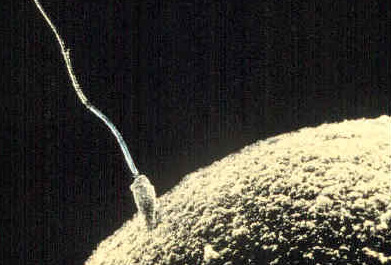sex : general article
صفحة 1 من اصل 1
 sex : general article
sex : general article
اضغط هنا للدخول لصفحة احدث ما اضيف للموقع
This article is about the sexes that occur in sexually reproducing organisms.

Organisms of many species are specialized into male and female varieties, each known as asex. Sexual reproduction involves the combining and mixing of genetic traits: specializedcells known as gametes combine to form offspring that inherit traits from each parent. Gametes can be identical in form and function (known as isogamy), but in many cases an asymmetry has evolved such that two sex-specific types of gametes (heterogametes) exist (known as anisogamy). By definition, male gametes are small, motile, and optimized to transport their genetic information over a distance, while female gametes are large, non-motile and contain the nutrients necessary for the early development of the young organism. Typically, males carry XY chromosomes, whereas females carry XX chromosomes.
The gametes produced by an organism determine its sex: males produce male gametes (spermatozoa, or sperm, in animals; pollen in plants) while females produce female gametes (ova, or egg cells); individual organisms which produce both male and female gametes are termed hermaphroditic. Frequently, physical differences are associated with the different sexes of an organism; these sexual dimorphisms can reflect the different reproductive pressures the sexes experience.
It is considered that sexual reproduction in eukaryotes first appeared about a billion years ago and evolved within ancestral single-celled eukaryotes.[2] The reason for the initial evolution of sex, and the reason(s) it has survived to the present, are still matters of debate. Some of the many plausible theories for the appearance of sexual reproduction include: the creation of variation among offspring, to spread advantageous traits, the beneficial removal of disadvantageous traits, and that sex evolved as an adaptation for repairing damage in DNA. (See the evolution of sexual reproduction.)
While there are a number of theories, there are two main alternative views on the evolutionary origin and adaptive significance of sex. The first view assumes that sexual reproduction is a process specific to eukaryotes, organisms whose cells contain a nucleus and mitochondria. In addition to sex in animals, plants, and fungi, there are other eukaryotes (e.g. the malaria parasite) that also engage in sexual reproduction. On this first view, the adaptive advantage that maintains sexual reproduction (in competition with asexual modes of reproduction) is the benefit of generating genetic variation among progeny. Furthermore, on this view, sex originated in a eukaryotic lineage. The earliest eukaryotes and the bacterial ancestors from which they arose are assumed to have lacked sex. For instance, some bacteria use conjugation to transfer genetic material between cells; and while not the same as sexual reproduction, this also results in the mixture of genetic traits. The reason that bacterial conjugation is not the same as sexual reproduction is that the numerous genes necessary for conjugation are not located on the bacterial chromosome, but on small circular DNA self-replicating parasitic elements called conjugative plasmids. Thus, conjugation arises from an adaptation of parasitic DNA for its own transmission.[3]
The second alternative view on the evolutionary origin and adaptive significance of sex is that sex existed in early bacteria as the process of natural transformation, a well studied DNA exchange process still in existence in many present day bacterial species (seeTransformation (genetics)). Transformation involves the transfer of DNA from a donor to a recipient bacterium. Recipient bacteria must first enter a special physiological state, termed competence, to receive donor DNA (see Natural competence). The numerous genes necessary for establishment of competence are located on the bacterial chromosome itself. Thus the process of transformation is likely beneficial to bacteria, and can be regarded as a simple form of sex. In general, competence is induced under stressful conditions, such as nutrient limitation and exposure to DNA damaging agents, as reviewed by a number of authors.[4][5][6] Sex, on this view, was present in the earliest single-celled eukaryotes because they were descended from ancestral bacteria capable of transformation. Sex was maintained as an adaptation for repairing DNA damage (see Evolution of sexual reproduction). In particular, meiosis the key stage of the sexual cycle of eukaryotes, in which genetic information derived from different individuals (parents) recombines, was likely derived from the analogous, but simpler, genetic information exchange and DNA repair process that occurs during transformation in bacteria[7][8][9][10] (and also see Meiosis, section: Origin and function of meiosis). Thus, by this view, sex appears to have evolved in bacteria as a way of repairing DNA damages induced by environmental stresses, was maintained through the prokaryote/eukaryote boundary, and continued to evolve in higher multicellular eukaryotes, in part, as a DNA repair process.
What is considered defining of sexual reproduction in eukaryotes is the difference between the gametes and the binary nature of fertilization. Multiplicity of gamete types within a species would still be considered a form of sexual reproduction. However, no third gamete is known in multicellular animals.[11][12][13]
While the evolution of sex itself dates to the prokaryote or early eukaryote stage, the origin of chromosomal sex determination may have been fairly early in eukaryotes. The ZW sex-determination system is shared by birds, some fish and some crustaceans. Mostmammals, but also some insects (Drosophila) and plants (Ginkgo) use XY sex-determination. X0 sex-determination is found in certaininsects.
No genes are shared between the avian ZW and mammal XY chromosomes,[14] and from a comparison between chicken and human, the Z chromosome appeared similar to the autosomal chromosome 9 in human, rather than X or Y, suggesting that the ZW and XY sex-determination systems do not share an origin, but that the sex chromosomes are derived from autosomal chromosomes of the common ancestor of birds and mammals. A paper from 2004 compared the chicken Z chromosome with platypus X chromosomes and suggested that the two systems are related.[15]

Eghelp- مشرف عام

-
 عدد المساهمات : 2823
عدد المساهمات : 2823
صفحة 1 من اصل 1
صلاحيات هذا المنتدى:
لاتستطيع الرد على المواضيع في هذا المنتدى







